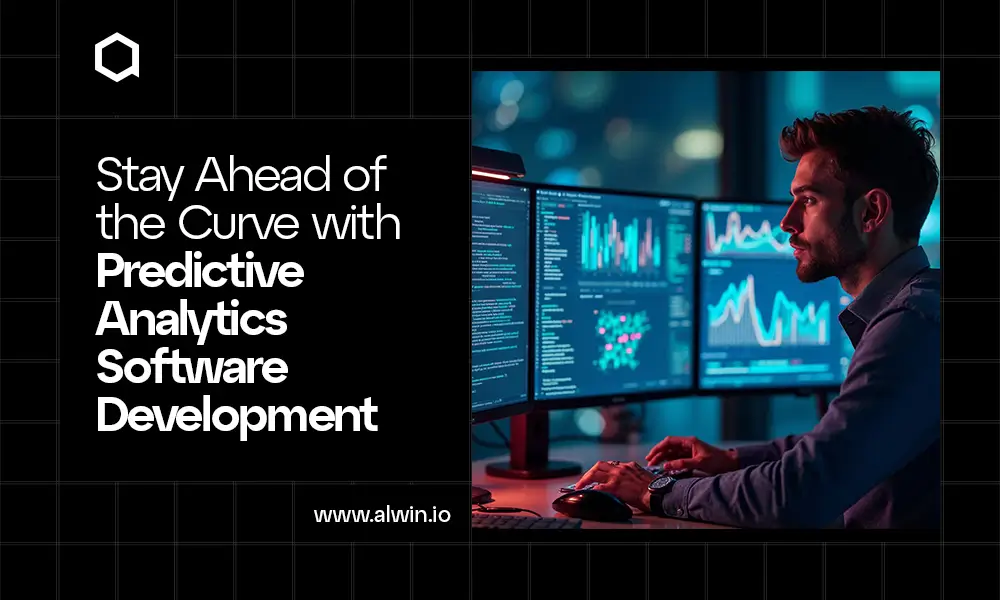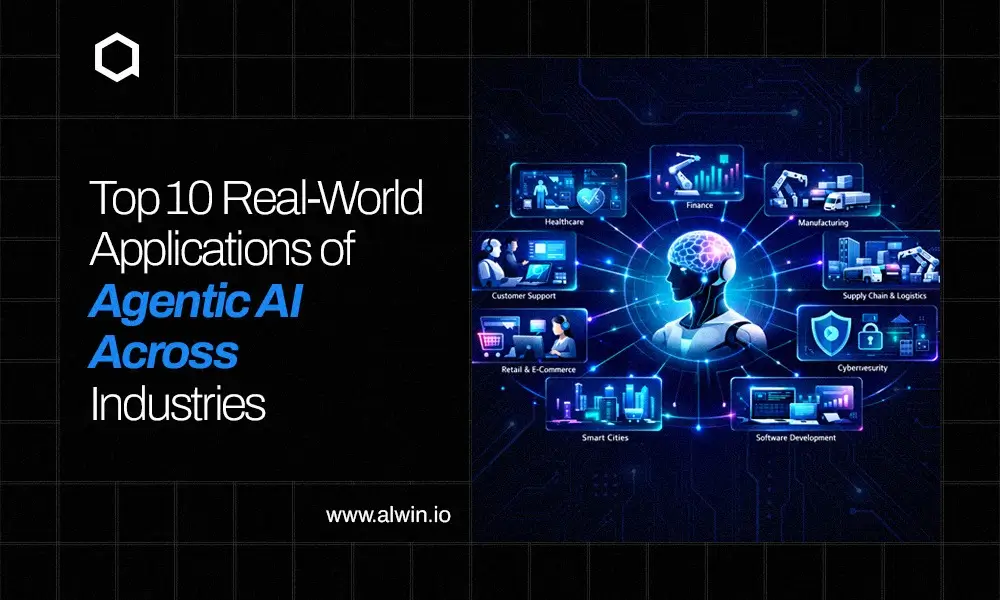Predictive analysis is a form of data analytics that uses historical data, machine learning, and statistical algorithms to forecast future outcomes. Unlike traditional analytics that focus on what has happened (descriptive) or why it happened (diagnostic), predictive analysis is forward-looking. It answers the key question, “What is likely to happen next?”
By identifying patterns and correlations in large datasets, predictive analysis allows businesses to anticipate risks, uncover new opportunities, and make decisions with greater confidence. It allows organisations to shift from reactive strategies to proactive ones, minimising surprises and maximising results.
Key takeaways:
Predictive analysis software influences historical data, machine learning, and statistical algorithms to forecast future outcomes.
It’s used to identify risks, uncover opportunities, and drive strategic decisions across industries.
Development involves creating personalised models that align with a company’s unique business goals, whether it’s forecasting customer churn, detecting fraud, or optimising inventory.
Integrates with business intelligence dashboards to provide real-time insights, helping companies act quickly and decisively.
The predictive analytics market is expected to grow from $12.5 billion in 2023 to $28.1 billion by 2026, at a CAGR of 21.7%.
Instance :
PayPal uses real-time predictive analytics to detect suspicious transactions. By analysing user behaviour, login patterns, and payment history, their systems predict and block fraudulent transactions within milliseconds.
Stat: Predictive models help prevent billions in losses each year.
Tesla leverages real-time predictive analytics to support its self-driving technology. By analyzing road, traffic, and sensor data, the system makes predictive decisions to avoid collisions and improve route efficiency.
How does it work?
Predictive analytics works by using data from the past to make smart guesses about the future. It starts by collecting historical data, like customer purchases, website visits, or sensor readings. That data is then cleaned and organised so computer models can use it. These models look for patterns and trends in the data using techniques like statistics and machine learning. Once trained, the models can make predictions, like which customer is likely to buy again or when a machine might break down. These predictions help businesses make better decisions in advance. With the help of predictive analysis software development, companies can automate this process, turning raw data into real-time insights they can act on quickly and confidently.
The Predictive Analysis Uprising in 2025: Driving Data into the Future
In 2025, predictive analysis will have become a driving force behind digital transformation, reshaping how organisations across the globe make decisions. With the exponential rise in data generation, businesses are rapidly adopting predictive models to stay ahead of customer demands, economic shifts, and operational challenges.
According to a recent MarketsandMarkets report, the global predictive analytics market is projected to grow from $12.5 billion in 2023 to $28.1 billion by 2026, at a CAGR of 21.7%. This growth is fuelled by growing demand across industries like healthcare, finance, retail, and logistics.
In fact, over 84% of enterprise-level organisations now consider predictive analytics essential for strategic decision-making. What’s more, the development of predictive analysis software has enabled companies to move beyond traditional analytics by building intelligent systems that forecast outcomes in real time.
These custom software solutions now integrate machine learning, real-time data feeds, and AI-driven automation, allowing businesses to reduce costs by up to 20%, improve customer retention by 25%, and boost marketing ROI by 30%. In 2025, predictive analytics isn’t just helpful; it’s an innovation for businesses that want to lead with data, not react to it.
From USD 14–19 billion in 2024 to potentially USD 100 billion+ by 2030–2034, predictive analytics is on a meteoric rise. Fuelled by AI progress, cloud integration, and strategic industry use cases, this sea change, often driven by predictive analysis software development, enables organisations to move from reactive to truly predictive, globally.
Role of Predictive Analytics Software Development
Predictive analytics software is a powerful tool that uses statistical models and data analysis techniques to evaluate both historical and current data in order to forecast future outcomes. Unlike traditional business intelligence tools that focus on past performance, predictive analytics helps organisations understand what is likely to happen next.
This type of predictive analytics software development supports:
Anticipating customer needs
Spotting market trends early
Detecting potential fraud
Improving the effectiveness of marketing campaigns
With real-time analytics capabilities, businesses can respond quickly to changing conditions, make informed decisions, reduce risk, and increase profitability.
Key Features of Predictive Analytics Software Development
In today’s hyper-connected digital world, data is everywhere. But raw data alone doesn’t drive decisions; it’s what you do with it that counts. That’s where predictive analytics steps in. Through advanced data modelling and intelligent automation, businesses are now predicting outcomes, behaviours, and market shifts before they happen. The real magic, however, lies in how this capability is built through predictive analytics software development.
Let’s explore the key features that make this technology a game-changer for modern businesses across industries.
1. Unified Data Integration
One of the first steps in predictive analytics is gathering data from various touchpoints, sales platforms, websites, customer support tools, IoT devices, mobile apps, and more. Predictive analytics software is designed to merge effortlessly with multiple data sources, offering businesses a full view of what’s happening in real time. Whether it’s structured or unstructured data, the system connects the dots to paint a complete and actionable picture.
Example: A logistics company can combine delivery tracking data, driver performance, and weather updates to forecast potential delivery delays.
2. Intelligent Data Cleaning & Preprocessing
Quality predictions start with quality data. Predictive software automatically cleans and prepares raw data by removing errors, filling gaps, and converting data into a standardised format. The models are built on solid ground, not on flawed or inconsistent data that could produce inaccurate results.
In simple terms, the system acts like a data janitor before becoming a data scientist.
3. Built-In Machine Learning & Statistical Models
At the heart of predictive analytics are machine learning algorithms and statistical models that detect patterns and trends. These models learn from historical data and apply that knowledge to forecast future events. Whether it's predicting sales, customer churn, or maintenance needs, the software uses techniques like
Linear and logistic regression
Decision trees
Time-series forecasting
Clustering and classification
Deep learning for complex data
And the best part? These models are often customized for specific industries or business goals.
4. Real-Time Prediction & Forecasting
Businesses today can’t afford to wait days or weeks for data reports. Predictive analytics software delivers real-time predictions, helping companies react instantly. It processes live data streams and updates forecasts on the fly, which is crucial for sectors like finance, cybersecurity, and e-commerce.
Imagine an e-commerce system adjusting product prices instantly based on real-time demand and competitor activity; that’s the power of real-time predictive analytics.
5. Interactive Dashboards & Visual Analytics
Numbers and code mean nothing unless people can understand them. Modern predictive systems come with beautiful, user-friendly dashboards that translate complex data into charts, graphs, heatmaps, and alerts. This allows team members, even non-tech professionals, to interpret data easily and make quick, confident decisions.
These dashboards help businesses turn predictions into insightful storytelling.
6. Custom Model Training & AutoML
Not all businesses operate the same way. You can train your own models on your company’s data to get more accurate, relevant results. Many platforms now offer AutoML (Automated Machine Learning) to simplify this process, allowing non-technical users to create strong models without deep programming knowledge.
7. Security & Regulatory Compliance
Predictive analytics deals with highly sensitive data, so security is non-negotiable. Good software comes equipped with
Data encryption
Role-based access control
Compliance with GDPR, HIPAA, and other standards
This ensures businesses stay safe while gaining powerful insights.
8. Scalable Cloud Architecture
Today’s predictive analytics tools are designed to scale. Cloud-based deployment means businesses can start small and expand as their data grows, without investing in heavy IT infrastructure. Whether you're running reports for 100 or 100,000 users, the platform remains stable, fast, and secure.
9. Continuous Learning & Model Updates
Predictive models are not static; they grow over time. With every new data point, the system gets smarter. It constantly retrains and adjusts itself to improve accuracy and applicability. This feature ensures that your predictions stay aligned with current trends and shifting market conditions.
10. Integration with Business Workflows
Finally, great predictive software doesn’t work in isolation. It integrates with existing tools like CRMs (Salesforce, HubSpot), marketing platforms, ERP systems, and more, helping teams put insights into action quickly.
Predictions are only valuable if they lead to real-time business impact, like sending alerts, triggering marketing campaigns, or adjusting production schedules.
Predictive Analytics Software Development Process
Creating effective predictive analytics software involves a well-defined and structured development lifecycle. Here's how the process typically unfolds:
1. Business Analysis & Data Audit
Begin by identifying the specific business objectives. Evaluate available data sources, assess data quality, and determine what data is needed for accurate forecasting.
2. Solution Architecture Design
Define the system architecture, select the right infrastructure, and design data models that align with business goals and scalability requirements.
3. Model Development
Develop predictive models based on statistical methods and historical data. This phase includes selecting algorithms, training models, and refining them to match the desired outcomes.
4. Integration & Testing
Integrate the solution with your existing platforms (CRM, ERP, etc.) and perform thorough testing to validate performance, data flow, and output accuracy.
5. Deployment
Deploy the system using a suitable environment—cloud-based, on-premise, or hybrid—based on your infrastructure and security needs.
6. Continuous Improvement
Monitor the performance of your predictive models, retrain them as new data becomes available, and apply updates to maintain accuracy and relevance.
A well-designed predictive analytics platform should be flexible and future-ready, making it easier to adopt new technologies and scale over time.
Technology Stack for Predictive Analytics Software
A strong tech stack forms the backbone of a successful predictive analytics solution. Here's a typical setup:
Programming Languages: Python, R, Scala
Frameworks: Scikit-learn, TensorFlow, PyTorch
Data Processing: Apache Spark, Hadoop, Kafka
Databases: PostgreSQL, MongoDB, Cassandra
Visualization: Tableau, Power BI, QlikView
Cloud Platforms: AWS, Google Cloud, Microsoft Azure
The right combination depends on project complexity, team expertise, and integration requirements.
Cost of Predictive Analytics Software Development
Budget planning is a critical part of any development project. The cost of building predictive analytics software varies based on a range of factors:
Project Scope & Features
The more complex the solution—such as including real-time analytics, multilingual support, or automation features—the higher the development effort and cost.
Data Volume & Infrastructure
Handling large volumes of structured and unstructured data demands robust storage, scalable computing power, and efficient pipelines, especially when hosted on the cloud.
Technology Stack
Using open-source tools can reduce licensing costs, while commercial or specialized platforms may increase overall expenditure depending on usage and hosting.
Team Composition & Location
Development costs vary greatly by region. Hiring offshore or nearshore teams can reduce expenses compared to building in-house U.S.-based teams. Team size and expertise (e.g., developers, analysts, data engineers) also affect the budget.
Security & Compliance
Solutions built for highly regulated sectors such as finance or healthcare must adhere to standards like HIPAA, GDPR, or SOC 2. This adds complexity to development and increases time and cost due to additional security and audit mechanisms.
Future Trends in Predictive Analytics for Software Development
As technology continues to grow, software is no longer just about writing code — it's about predicting what will happen next. That’s where predictive analytics is making a huge impact. From understanding user behavior to reducing bugs before they happen, predictive analytics is changing how software is developed, tested, and improved.
Let’s explore some of the big future trends in predictive analytics that are shaping the next generation of software development, explained in simple, easy-to-understand words.
1. Smart AI + Predictive Analytics
In the future, software will be more intelligent than ever. Predictive analytics and AI (Artificial Intelligence) will work together to make software smarter. Instead of reacting to problems after they happen, future systems will predict issues before they cause damage. For example, an app might know that a feature is going to slow down or crash and fix it in advance.
2. Predictive Testing: Catching Bugs Before You Code
One exciting trend is predictive testing. Using past data and test results, developers can now predict where bugs are most likely to appear, even before the code is written. This saves time and money, and makes software more reliable.
Imagine your software telling you, “This part of your app might crash after a new update” before you even launch it!
3. Personalized User Experiences
In the future, software will learn from each user and give them a customized experience. Predictive analytics will study how people use apps and websites, and then adjust the layout, speed, or features based on their preferences.
For example: A music app might suggest songs you’ll love — even before you search for them.
4. Data-Driven Decision Making
As predictive analytics becomes more powerful, software teams will rely less on guesswork and more on data-backed decisions. Teams can predict how long a project might take, what features customers will want, and what problems might arise — all based on past trends and patterns.
This means better planning, fewer surprises, and smarter product releases.
5. Cloud + Predictive Analytics: Real-Time Speed
With cloud technology growing fast, predictive analytics will run faster and in real-time. Developers and businesses won’t have to wait for long reports — they’ll get instant predictions, updates, and alerts. This helps them act quickly and stay ahead of issues.
6. Predicting Security Threats
Cybersecurity is a major concern in software development. In the future, predictive analytics will be used to spot threats before they happen. Software will learn from attack patterns and raise red flags if something looks suspicious, helping protect apps and users automatically.
7. Continuous Learning & Auto-Updating Systems
Software will become self-learning. Predictive models will keep learning as more data comes in, and the system will improve itself without needing manual input. This is called automated model retraining, and it keeps your predictions fresh and accurate all the time.
8. Predictive Analytics in Chatbots and Virtual Assistants
In the future, virtual assistants and chatbots will become more human-like, thanks to predictive analytics. They will learn from each interaction, understand user intent better, and offer smarter replies — even before you finish typing your question.
At WeAlwin, a trusted Decentralized Prediction Marketplace Development Company, we don’t just build predictive systems—we create practical solutions that match your business goals. Whether you're starting from scratch or improving an existing setup, our full-stack development teams are ready to support your project from concept to deployment.
Define clear performance indicators (KPIs)
Choose the right models and methods for your needs
Build secure, scalable, cloud-ready solutions
Provide ongoing support and regular updates
Predictive analytics helps businesses handle complexity, spot opportunities early, and make informed decisions. Whether you're a startup refining customer strategies or a large company improving operations, it offers a clear path to better outcomes.
Let’s put your data to work. Contact us to build a predictive analytics solution tailored to your business.
FAQs
Q1: What is predictive analytics software development?
Predictive analytics software development is the process of building intelligent software systems that can analyze past data to forecast future outcomes. These tools use machine learning, statistical models, and AI to help businesses make smarter, data-driven decisions, such as predicting customer behavior, sales trends, or system failures.
Q2: Why is predictive analytics important in software development?
Predictive analytics helps developers and companies improve software quality, reduce bugs, and understand user needs more clearly. It allows teams to anticipate problems before they occur, personalize user experiences, and build faster, smarter applications based on data insights.
Q3: How does predictive analytics work?
Predictive analytics works by analyzing historical data, identifying patterns, and using mathematical models to forecast future events. For example, it can analyze purchase history to predict what a customer will buy next or monitor system logs to forecast when a server might fail.
Q4: Can predictive analytics be integrated into existing software?
A: Yes. Predictive analytics solutions are often built to integrate easily with existing platforms like CRMs, ERPs, mobile apps, or e-commerce systems. Custom APIs and cloud-based tools make it easier to add predictive features to your current software stack.
Q5: How do businesses get started with predictive analytics software development?
Start by identifying your goals, such as reducing churn, improving forecasts, or detecting fraud. Then, gather historical data and partner with a development team or company that specializes in predictive analytics software development to build a custom solution tailored to your business needs.



